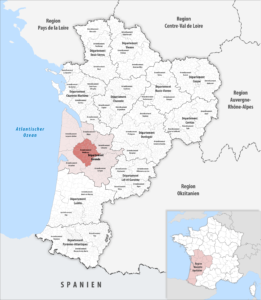BORDEAUX

Location
The Bordeaux wine region is situated in southwestern France, centered around the city of Bordeaux.
It covers the entire area of the Gironde department in the Aquitaine region.
The region is naturally divided by the Gironde Estuary into the Left Bank and the Right Bank.
Grape Variety:
Bordeaux wines are typically blends of different grape varieties.
Red Bordeaux wines often include the following grape varieties:
Cabernet Sauvignon: Predominant on the Left Bank.
Merlot: Commonly found on the Right Bank.
Cabernet Franc, Malbec, and Petit Verdot are also used in varying proportions.
White Bordeaux wines are made from grapes such as Sauvignon Blanc, Sémillon, and Muscadelle.
Climate:
Bordeaux benefits from a temperate climate influenced by the nearby Atlantic Ocean.
The three rivers (Gironde, Garonne, and Dordogne) create an ideal setting for viticulture.
The short winter and high humidity contribute to successful wine production.
History:
Bordeaux has a rich winemaking tradition dating back centuries.
The region is home to prestigious châteaux (wine estates) that produce both red and white wines.
Winemakers follow strict regulations set by the Appellation d’Origine Contrôlée (AOC) laws.
Famous Wines:
Bordeaux boasts several renowned wine appellations:
Médoc: Known for its Left Bank wines, including sub-regions like St-Estèphe, Pauillac, St.-Julien, and Margaux.
G
raves: Produces both red and white wines, with Pessac-Léognan and Sauternes as notable sub-regions.
Saint-Émilion and Pomerol: Prominent on the Right Bank.
Sauternes: Famous for its botrytized dessert wines.
Entre-Deux-Mers: Lies between the Garonne and Dordogne rivers, producing sweet wines like Cadillac and St. Croix de Mont.